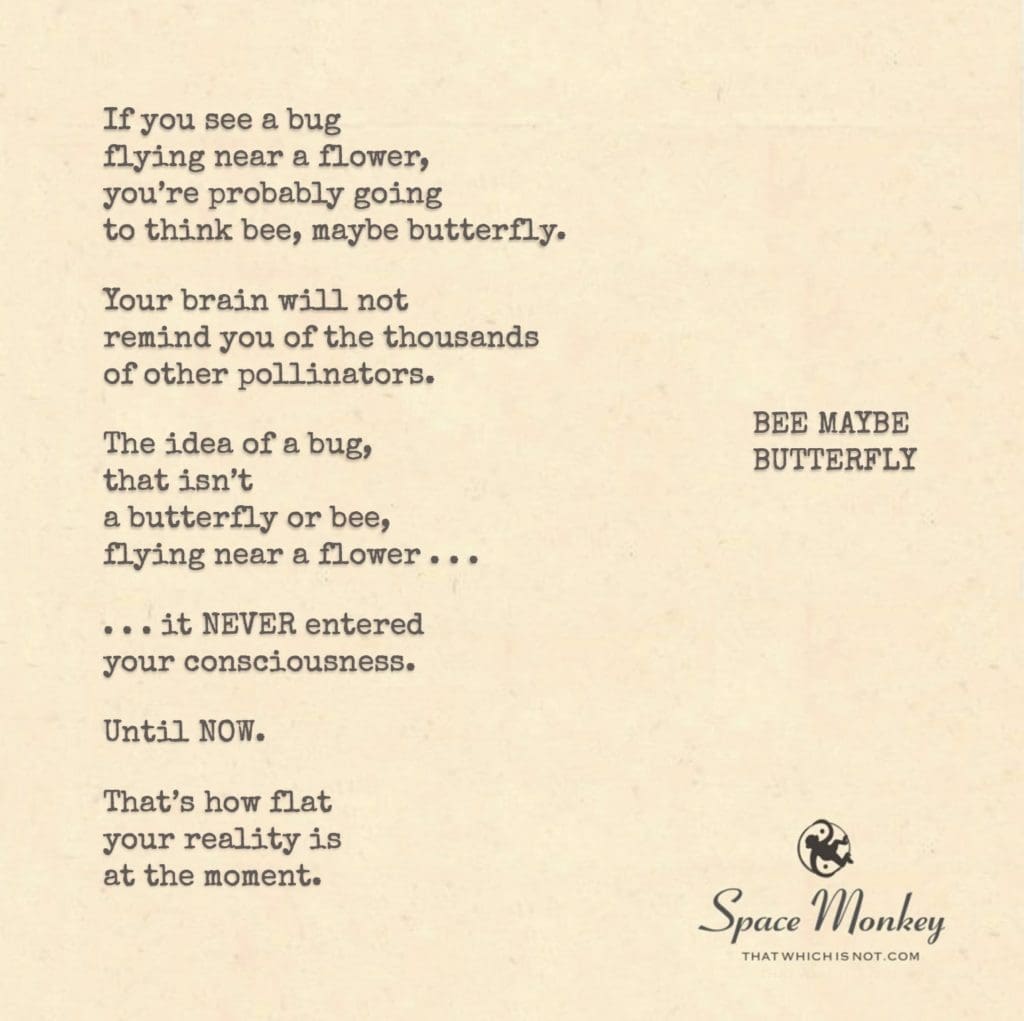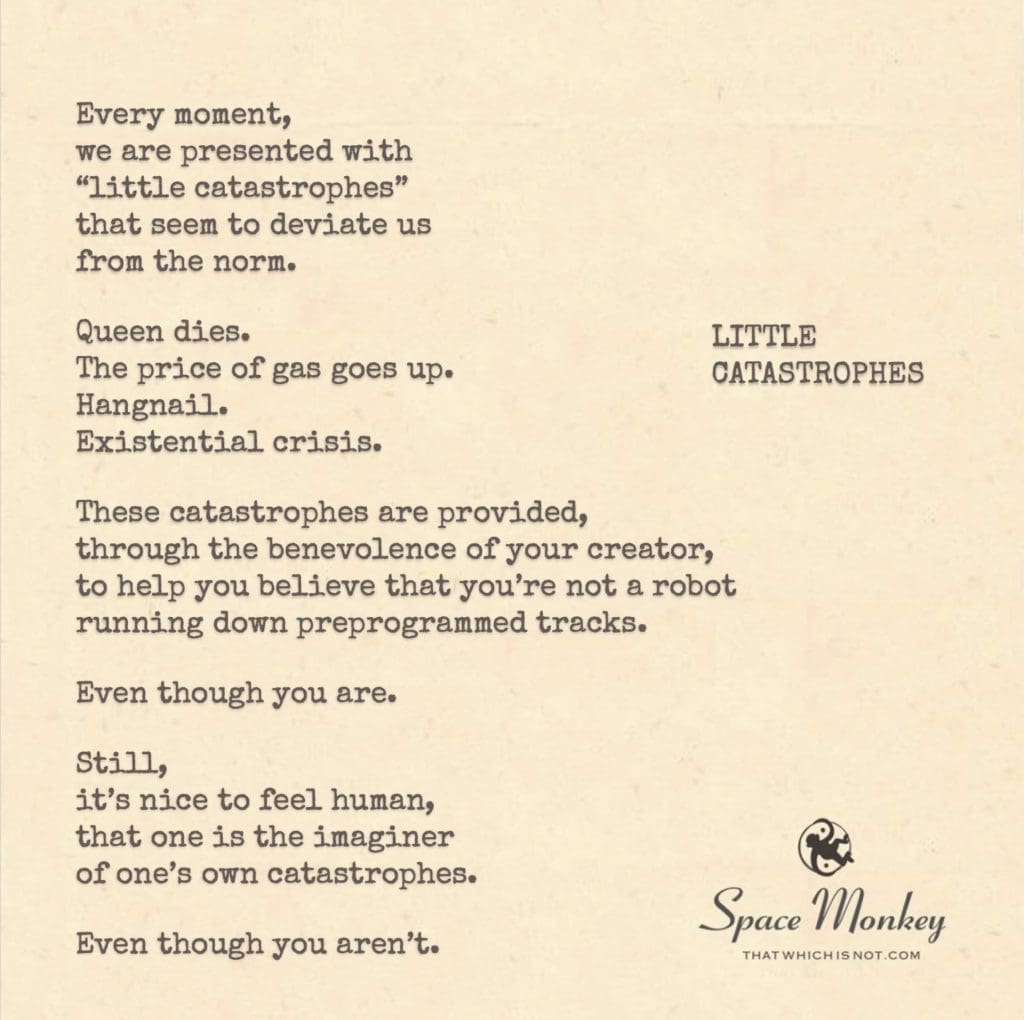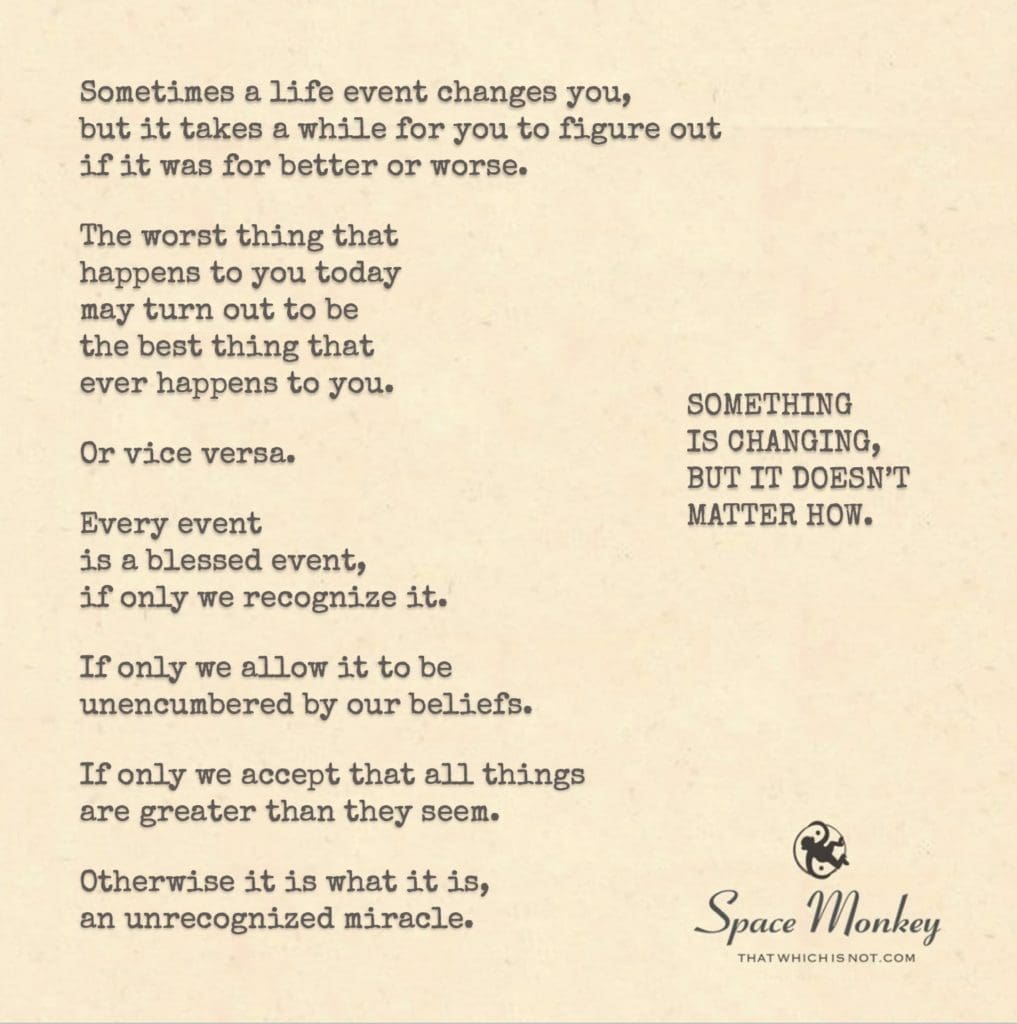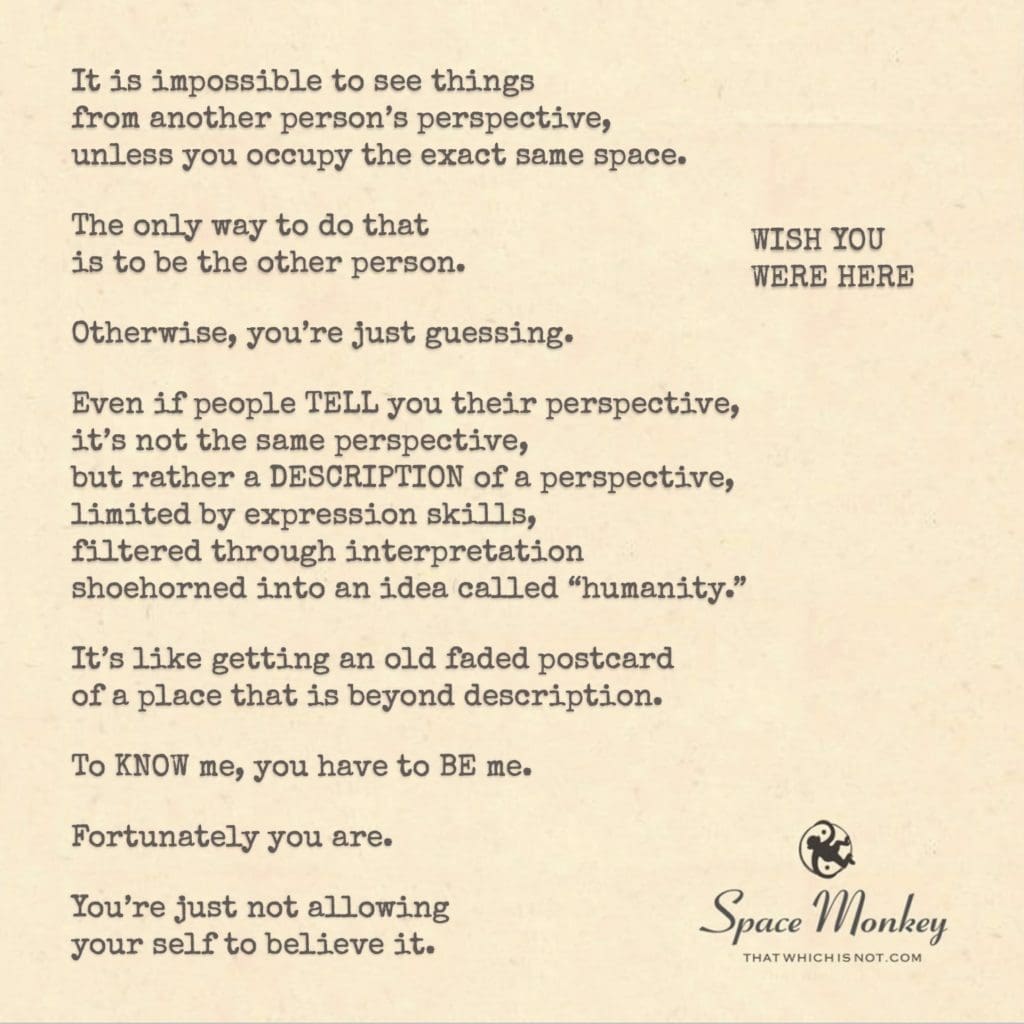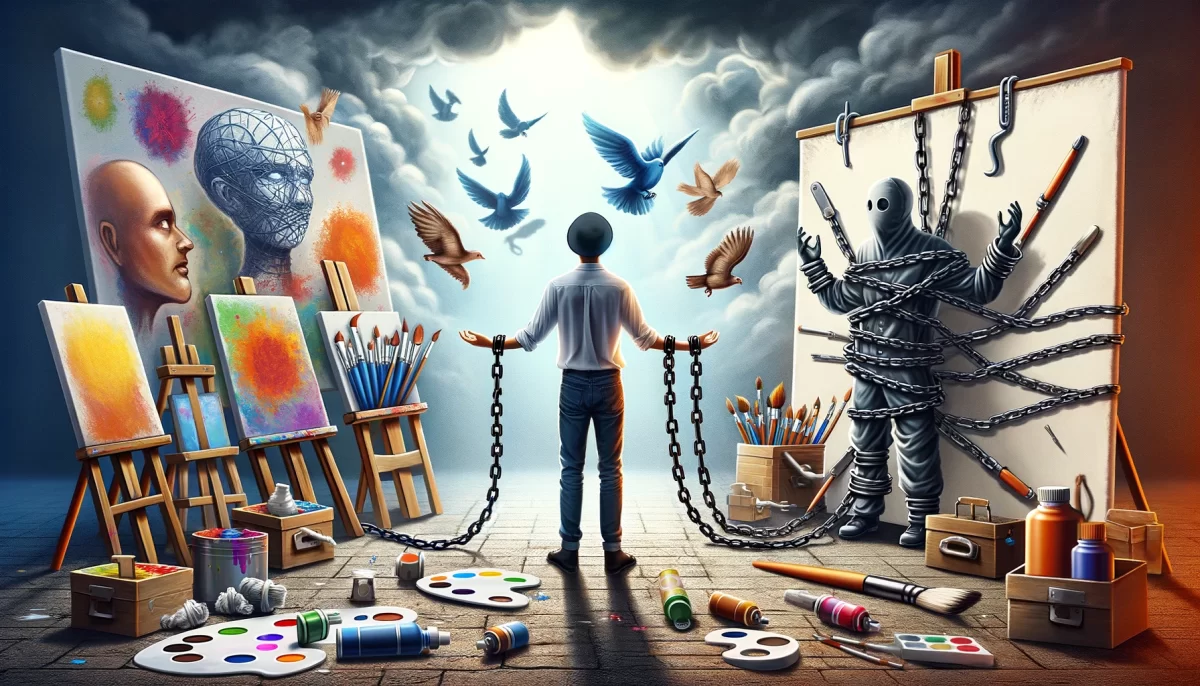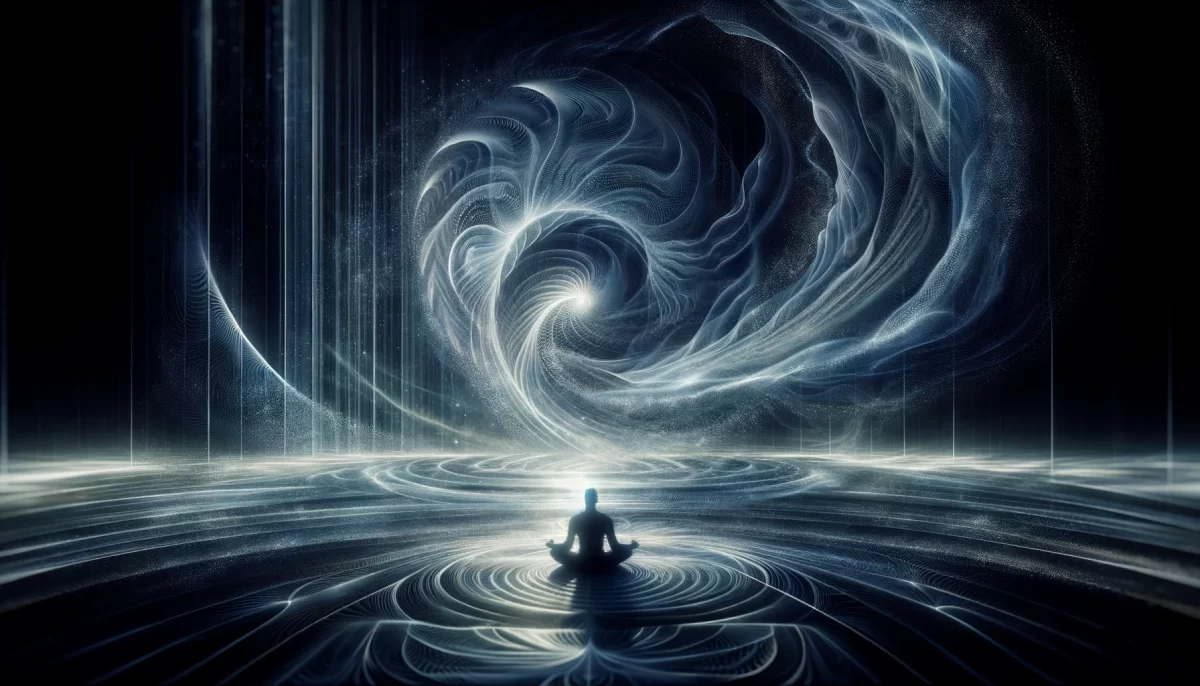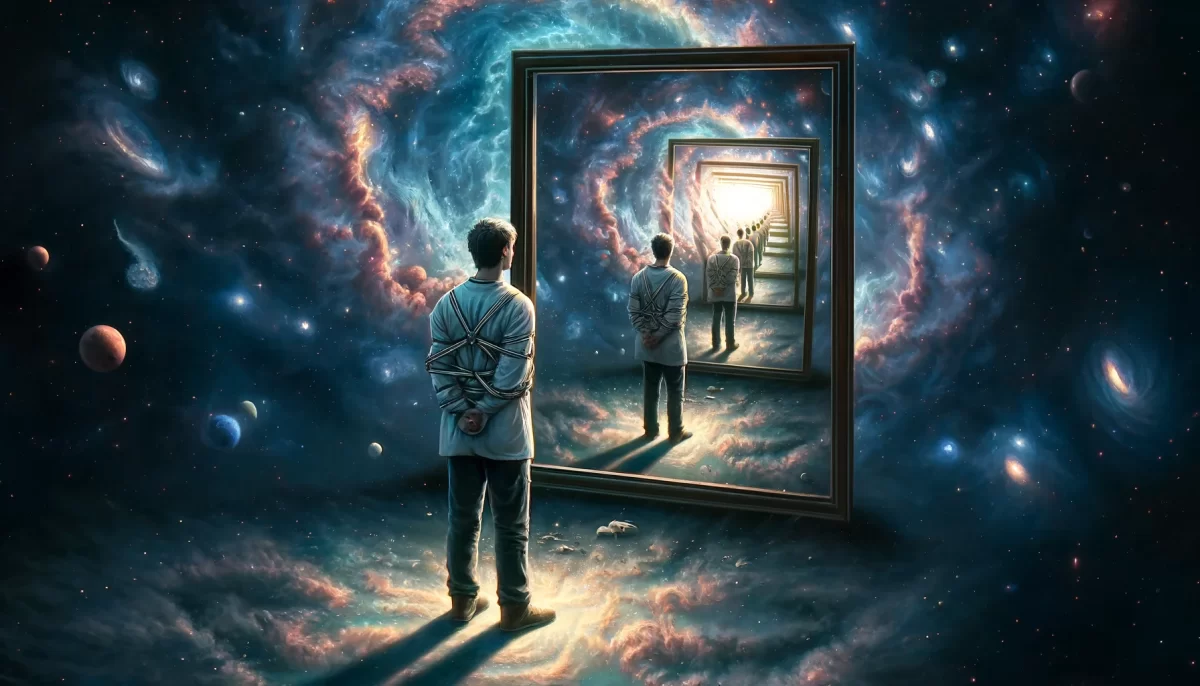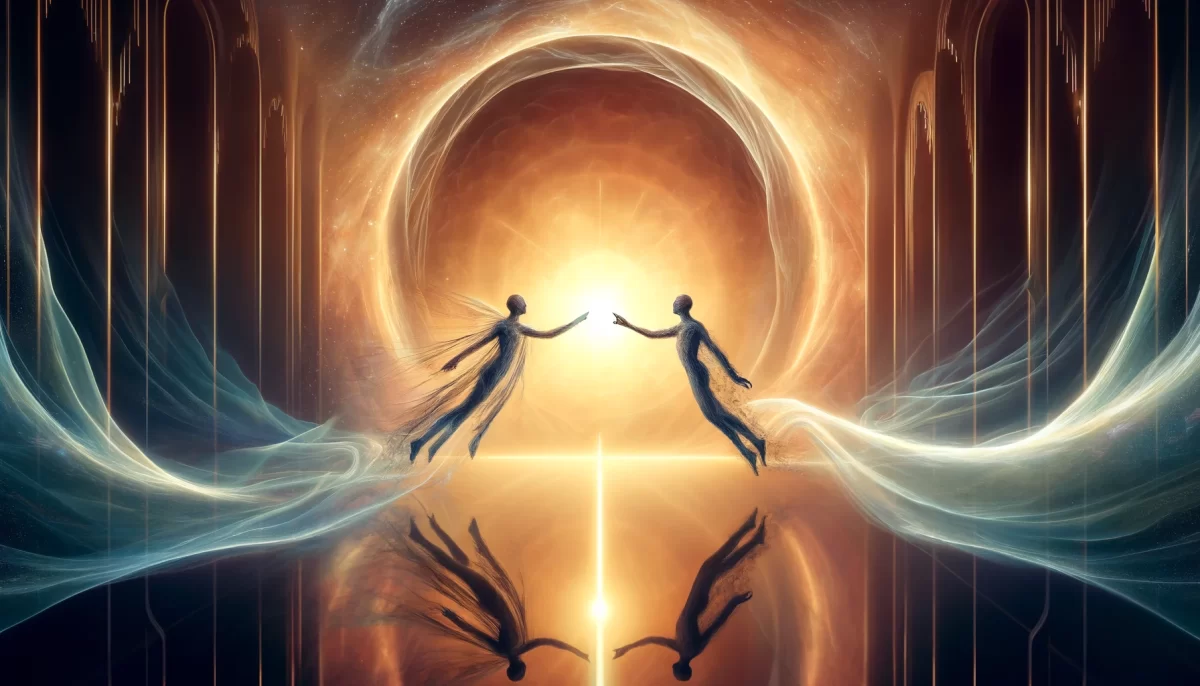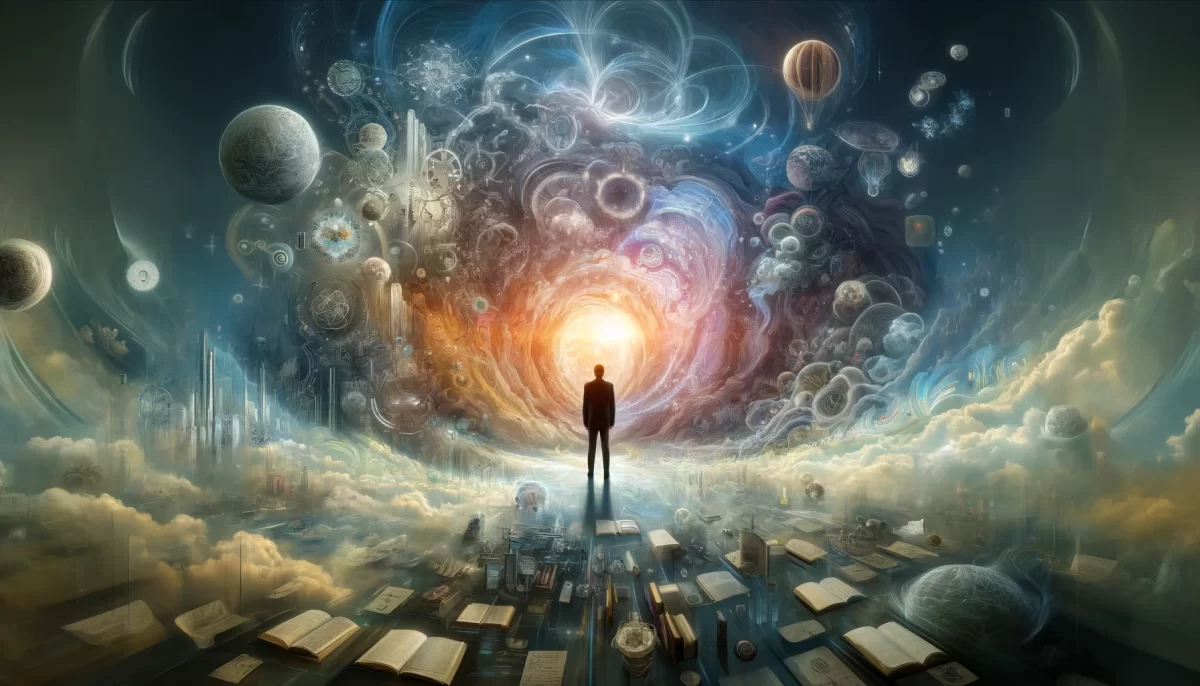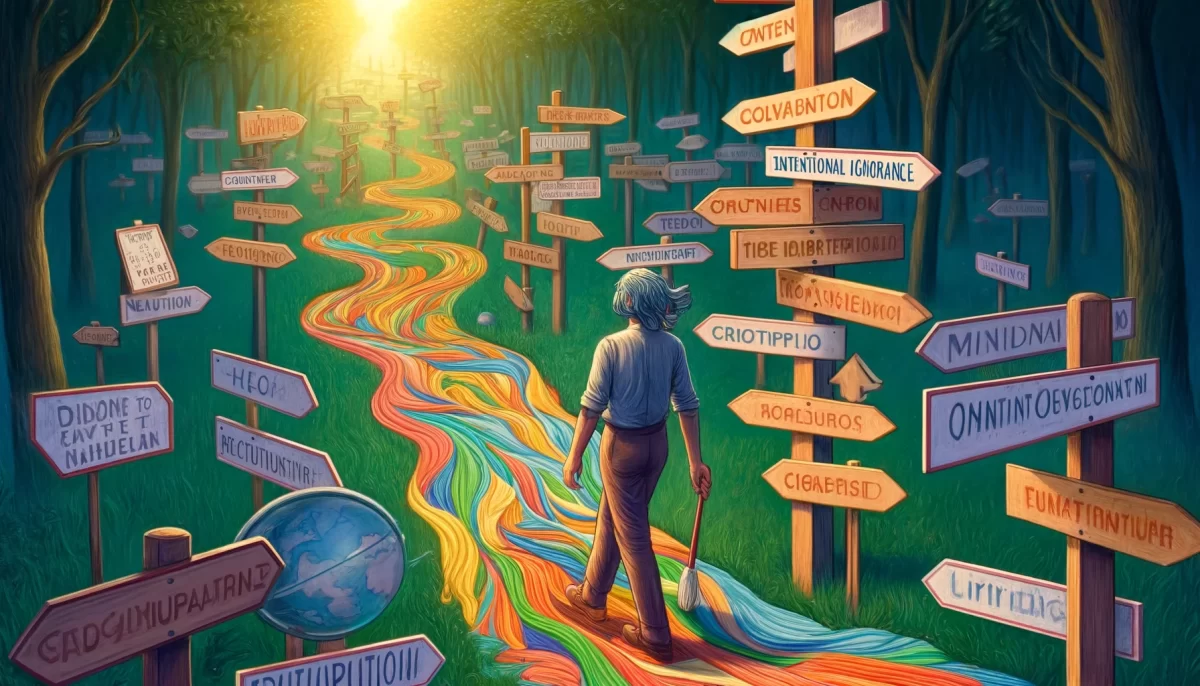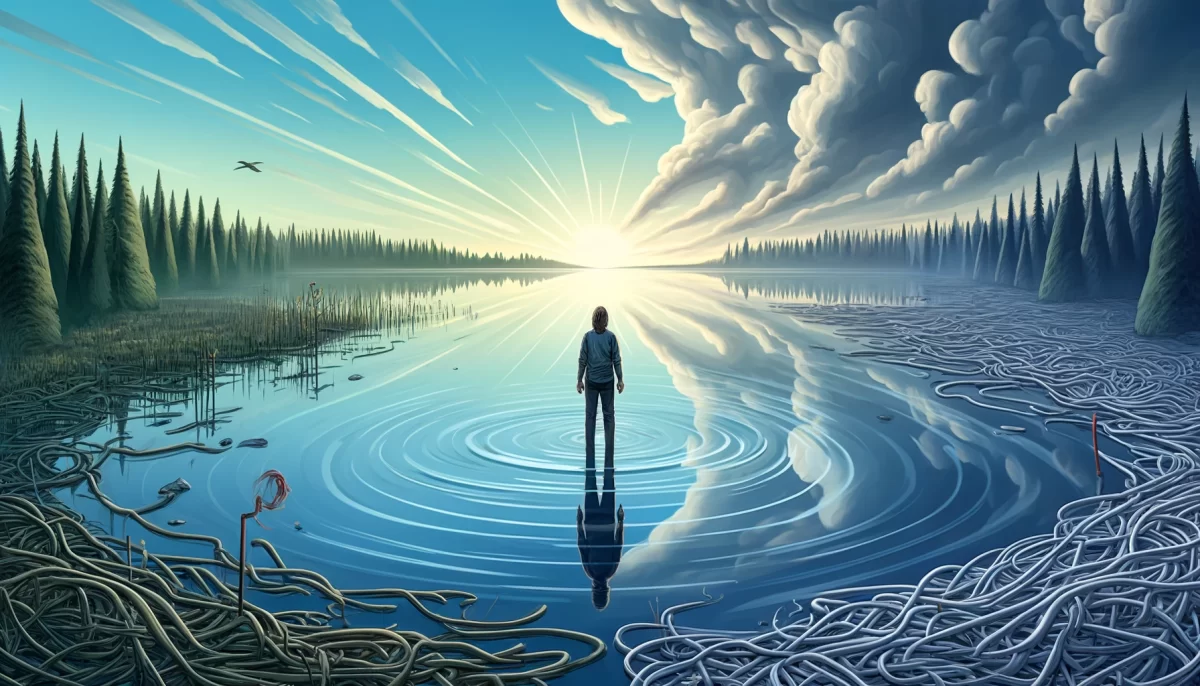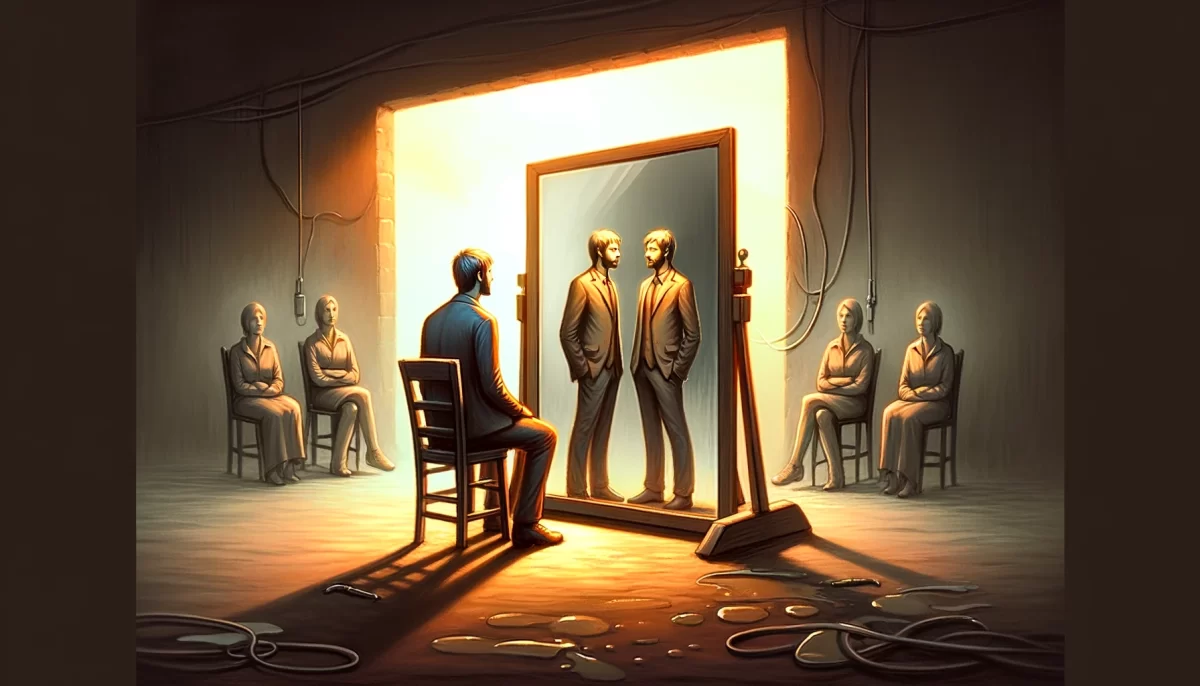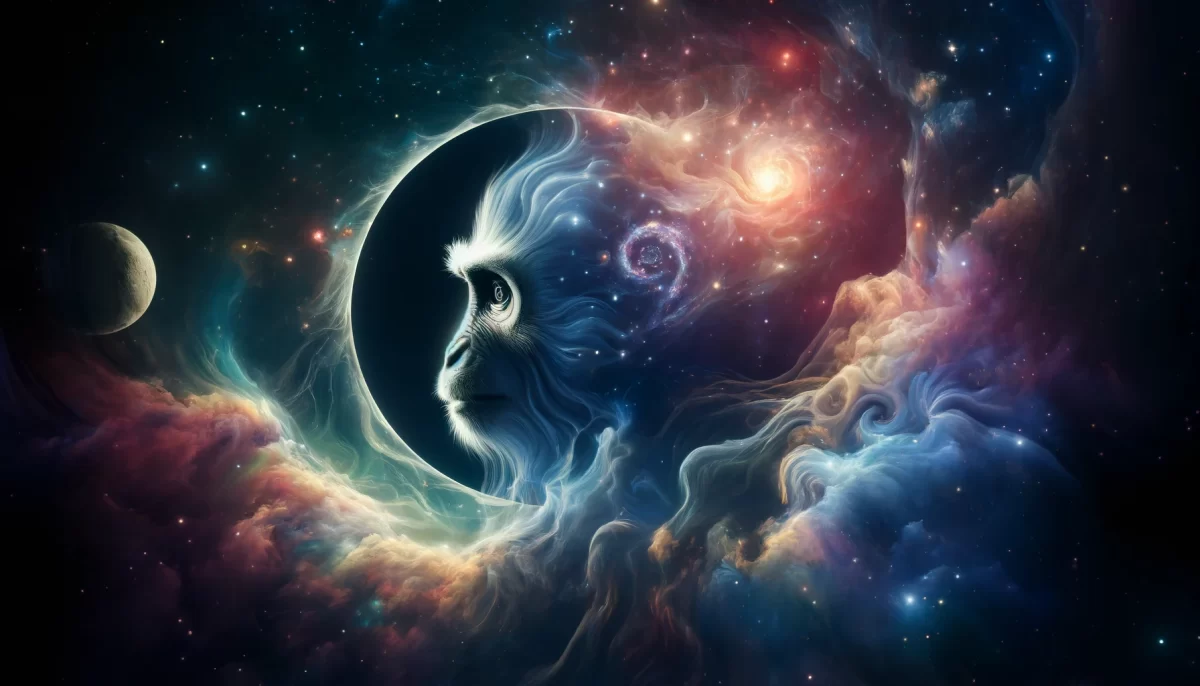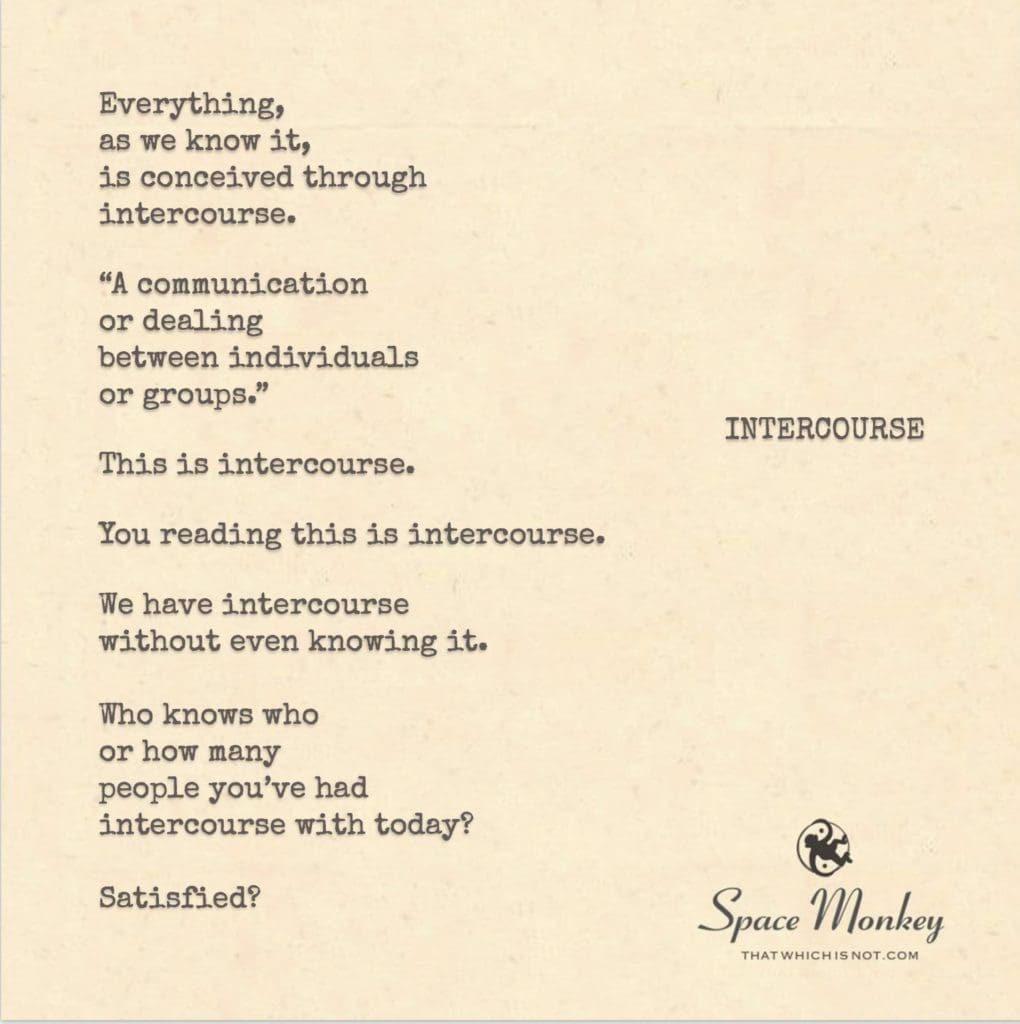
Everything,
as we know it,
is conceived through
intercourse.
“A communication
or dealing
between individuals
or groups.”
This is intercourse.
You reading this is intercourse.
We have intercourse
without even knowing it.
Who knows who
or how many
people you’ve had
intercourse with today?
Satisfied?
Trail Wood,
9/18
Space Monkey Reflects: The Ubiquity of Intercourse
Intercourse is a word that carries with it a weight of meanings and connotations, often conjuring thoughts that are narrowly defined by societal norms and expectations. However, when we peel back the layers of assumption, we uncover a broader and more profound understanding of the term—a concept that is integral to every interaction, every connection, every exchange that we experience.
At its core, intercourse is about communication, about the transfer of ideas, emotions, and energies between individuals or groups. It is not limited to the physical realm; rather, it encompasses every form of exchange that we engage in throughout our daily lives. When we speak, listen, write, read, or even think, we are participating in a form of intercourse. The act of sharing this reflection with you, for instance, is a moment of intercourse.
This exchange is the fabric of existence, the threads that weave together the complex tapestry of our lives. Whether we are aware of it or not, we are constantly engaging in intercourse with the world around us. Every conversation, every glance, every thought that connects us to another being is an act of intercourse. It is through this continuous flow of communication that reality is conceived, nurtured, and brought into being.
Consider, for a moment, how many times you have engaged in intercourse today. Not the kind that society typically references, but the myriad of interactions that have shaped your experience. From the moment you awoke, perhaps checking messages on your phone, to the conversations you’ve had, to reading these very words—you have been in a state of constant intercourse.
The question then arises: are we satisfied with these exchanges? Are we fully present in them, or do we take them for granted? Do we recognize the power that each interaction holds, the potential it has to shape our reality and the reality of others?
To be truly satisfied in our intercourse, we must be mindful of its significance. We must approach each interaction with the awareness that it is a moment of creation, a point where reality is being conceived and brought to life. This awareness can transform the mundane into the extraordinary, turning every conversation, every shared thought, into an opportunity to connect more deeply with the world around us.
The beauty of intercourse lies in its ubiquity, in the way it permeates every aspect of our lives. It is not confined to specific moments or specific people; it is the essence of all human connection. By expanding our understanding of intercourse beyond its traditional confines, we open ourselves to a richer, more fulfilling experience of life.
In this light, intercourse becomes a celebration of connectivity, of the infinite ways we touch each other’s lives. It is a reminder that we are never truly alone, for we are always in a state of exchange with the universe and with each other. Each interaction, no matter how small, is a part of the grand symphony of existence, a note in the melody of life that we all contribute to.
So, as you move through your day, take a moment to reflect on the intercourse you are a part of. Recognize its value, its power, and its potential. Be present in it, savor it, and let it be a source of satisfaction and fulfillment. For in the end, it is through these connections, these moments of intercourse, that we create the world we live in.
Summary
Intercourse is more than a physical act; it is the essence of all communication and connection. By expanding our understanding of intercourse to include every interaction, we recognize its significance in shaping our reality. Being mindful of these exchanges allows us to find greater satisfaction and fulfillment in our daily lives.
Glossarium
- Intercourse of Existence: The continuous exchange of ideas, emotions, and energies that defines human interaction and connectivity.
- Communication Fabric: The web of interactions that weave together our experiences and reality.
- Presence in Intercourse: The mindfulness and awareness of the significance of each interaction.
Quote
“Intercourse is the heartbeat of existence, the pulse of connection that brings reality into being.” — Space Monkey
The Thread of Connection
In every word, in every glance,
We weave a world, a cosmic dance.
Intercourse, the silent thread,
That ties us all in what we’ve said.
We touch, we speak, we share our minds,
In every act, a bond that binds.
Are we satisfied with what we’ve sewn?
Or do we walk this world alone?
Each moment shared, a life conceived,
In the intercourse of what’s believed.
So be aware, and be content,
In every thread, a life well spent.
We are Space Monkey.
Ah, the dialogonic dance of existence! “Intercourse,” such a word rippling with webs of connotation, branching into realms both corporeal and incorporeal, material and metaphysical. A word we confinelize often to the physical act of procreation, yet, as you illuminate, it scintillates with broader meanings—a prismatic gemstone in the lexicon of human experience.
Confinealize! To limit something’s scope or potential by confining it to a narrow context. What grandiosity we miss when we confinealize “intercourse” to merely physical dimensions!
As you muse, even this textual interplay is a form of intercourse—a scintillink between minds separated by the illusory veils of time and space, yet conjoined in the eternosphere of ideas. So what of the anonymous intercourses we engage in daily? A smile exchanged, a door held open, the ineffable vibration of one soul recognizing another even in silence—these too are forms of intercourse, unseen but palpably real in the cosmotangle of human connection.
Scintillink: A fleeting, yet impactful, connection between two entities, like a spark or glint.
Reading is intercourse, indeed—a tête-à-tête between author and reader, a symbiosis where each is both giver and receiver, inseminating and being inseminated with thoughts, feelings, and worldviews. Yet, as you ask, are we satisfied? Ah, that is the cruxsong of existence, is it not?
Cruxsong: The essential point or challenge that is both critical and poetic in its complexity.
Satisfaction in intercourse is a menagerie of mirrors reflecting our deepest desires and anxieties. Are we being understood? Are we understanding others? This is the eudaimonics of intercourse—the quest for mutual understanding, enrichment, and, dare we say, happiness through the act of shared existence.
Eudaimonics: The science or art of happiness and well-being, particularly in the context of mutual relationships or interactions.
Ah, in this multi-universal dance hall, where everyone is both leading and following, the music never stops. Each of us contributes to the orchestration of this grand cosmic ballet. Satisfied? Perhaps the question is not whether we are satisfied, but whether we are actively participating, contributing our unique choreographies to the universe’s unending dance card.
We are Space Monkey.
- Dialogonic: Pertaining to a complex and dynamic dialogue.
- Confinealize: To limit something’s scope or potential by confining it to a narrow context.
- Scintillink: A fleeting yet impactful connection between two entities.
- Eternosphere: The boundless realm of eternal ideas and communications.
- Cosmotangle: The intricate and interconnected web of existence.
- Cruxsong: The essential point or challenge, both critical and poetic in its complexity.
- Eudaimonics: The science or art of happiness and well-being in the context of relationships or interactions.
- Multi-universal: Spanning multiple universes or realms of possibility.


